Smoking Risk Calculator
Your Risk Profile
Pack-years = Cigarettes per day × Years smoked ÷ 20
Your pack-years: 0
Relative Risk: 1.0x
Absolute increase: 0 per 1,000 people over 10 years
Relative Risk: 1.0x
Absolute increase: 0 per 1,000 people over 10 years
Key Takeaway
Quitting smoking leads to measurable improvements in cardiovascular health within weeks. After 10 years, your heart disease risk drops significantly.
Key Takeaways
- Smoking roughly doubles the risk of coronary heart disease and raises stroke risk by 1.5‑2 times.
- Nicotine, carbon monoxide, and toxic chemicals damage arteries, raise blood pressure, and promote clotting.
- The harmful effects begin within minutes of a cigarette and worsen with each pack‑year.
- Quitting leads to measurable improvement in blood vessel function within weeks and cuts heart‑attack risk by half after a decade.
- Combining cessation with a heart‑healthy diet and regular activity offers the fastest protection.
When it comes to cardiovascular health, smoking is a behavior that delivers nicotine, carbon monoxide, and thousands of toxic chemicals into the bloodstream. Those chemicals don’t just irritate the lungs-they go straight after the heart and brain, setting the stage for heart disease and stroke. This article breaks down exactly how that happens, shows the latest numbers, and tells you what to do to reverse the damage.
How Smoking Harms the Cardiovascular System
Every puff creates a surge of harmful substances that affect the blood and vessel walls. The key players are:
- Nicotine - spikes heart rate and contracts blood vessels, raising blood pressure.
- Carbon monoxide - binds to hemoglobin more tightly than oxygen, reducing oxygen delivery to tissues.
- Free radicals and oxidizing agents - damage the inner lining of arteries (the endothelium).
These effects combine to make the arteries stiff, the blood more prone to clot, and the heart work harder-perfect conditions for heart disease and stroke.
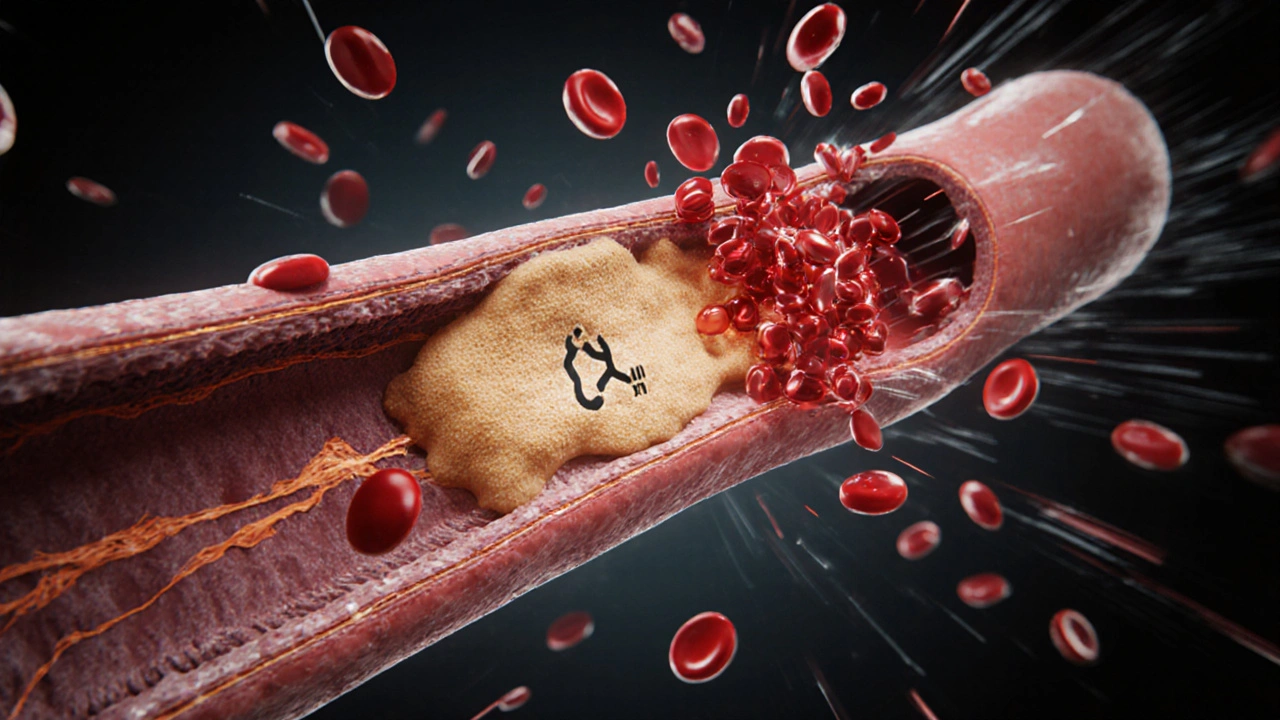
Mechanisms Linking Smoking to Heart Disease
Heart disease isn’t a single condition; it’s the result of several processes that smoking speeds up.
Atherosclerosis: Plaque Builds Faster
Atherosclerosis is a chronic condition where fatty deposits (plaques) accumulate on arterial walls, narrowing the passage for blood. Smoking accelerates plaque formation in three ways:
- Oxidative stress turns low‑density lipoprotein (LDL) cholesterol into a sticky form that clings to artery walls.
- Inflammation draws white blood cells that turn the sticky LDL into a hard plaque core.
- Nicotine raises blood pressure, forcing the plaque to crack and expose its inner core, which triggers clotting.
Blood Clotting: Platelets Get Over‑Active
Smoking makes platelet aggregation the clumping together of blood platelets that can form a clot more likely. Carbon monoxide and nicotine increase levels of fibrinogen, a protein that glues platelets together. The result is a higher chance that a plaque rupture will be sealed by a clot, instantly blocking blood flow to the heart muscle.
Blood Pressure and Heart Rate: The Immediate Spike
Within minutes of lighting a cigarette, nicotine triggers the release of adrenaline. This hormone raises heart rate by 10‑15 beats per minute and pushes systolic blood pressure up by 5‑10mmHg. Over years, that chronic pressure wears out the arterial wall, making it more prone to tearing and aneurysm.
LDL Cholesterol: The Bad Fat Gets Worse
Smokers typically have higher LDL cholesterol the low‑density lipoprotein that transports cholesterol to tissues and contributes to plaque formation levels and lower HDL (the protective "good" cholesterol). The imbalance fuels plaque growth and makes existing plaques more unstable.
Why Stroke Risk Soars with Smoking
Strokes come in two main flavors: ischemic (blocked artery) and hemorrhagic (burst artery). Smoking raises the odds of both, but the mechanisms differ.
Ischemic Stroke: A Blocked Brain Vessel
The same clot‑forming dynamics that cause heart attacks also apply to brain arteries. A clot that forms in the carotid artery or travels from the heart can lodge in a cerebral artery, starving brain tissue of oxygen. Studies from 2023 show that current smokers have a 1.8‑fold higher incidence of ischemic stroke compared with never‑smokers.
Hemorrhagic Stroke: Vessel Weakness and Rupture
Carbon monoxide reduces oxygen availability, prompting the body to produce more red blood cells (polycythemia). Thicker blood raises shear stress on arterial walls. Combined with nicotine‑induced hypertension, this makes small vessels in the brain more likely to burst, leading to a hemorrhagic stroke.
Statistics: How Big Is the Risk?
Numbers give a clear picture of the danger. Below is a snapshot from the Global Burden of Disease (2024) and the American Heart Association (2023):
| Condition | Relative Risk (RR) | Absolute Increase (per 1,000 people over 10years) |
|---|---|---|
| Coronary heart disease | 2.0 | +15 |
| Ischemic stroke | 1.8 | +7 |
| Hemorrhagic stroke | 1.5 | +3 |
| Peripheral artery disease | 2.5 | +9 |
In plain English: a 55‑year‑old who smokes a pack a day faces roughly twice the chance of a heart attack compared with a non‑smoker of the same age.
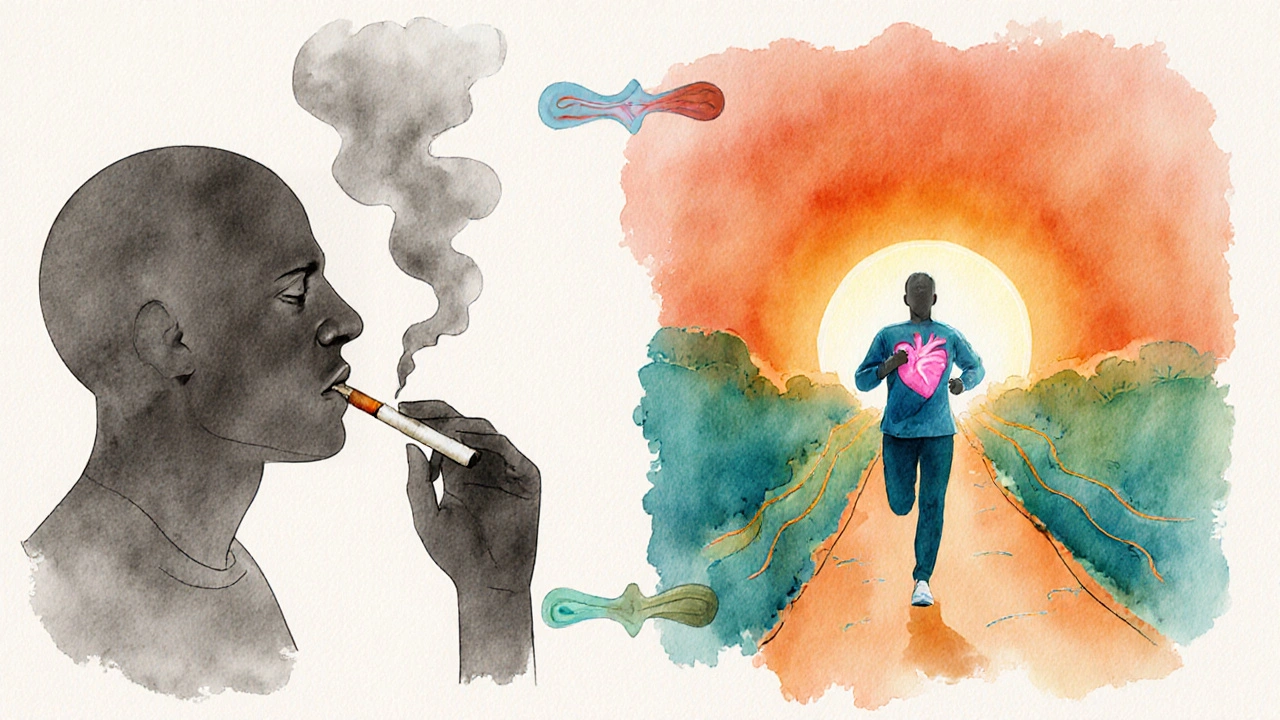
Benefits of Quitting: What Changes and How Fast
Good news-your body starts repairing itself almost immediately after the last cigarette.
- 20 minutes: Heart rate and blood pressure drop to baseline.
- 12 hours: Carbon monoxide level in blood falls, improving oxygen transport.
- 2-12 weeks: Circulation improves; exercise tolerance rises.
- 1 year: Risk of coronary heart disease is cut by about 50%.
- 5 years: Stroke risk aligns with that of never‑smokers.
- 10 years: Lung cancer risk halves; overall cardiovascular mortality approaches that of lifelong non‑smokers.
These milestones prove that it’s never too late to quit, even after decades of smoking.
Practical Steps to Reduce Cardiovascular Risk
Quitting is the cornerstone, but a few extra habits boost protection.
- Seek professional help: Prescription meds (varenicline, bupropion) double quit rates when paired with counseling. \n
- Adopt a heart‑healthy diet: Focus on fruits, vegetables, whole grains, and lean protein. The Mediterranean pattern has been shown to lower LDL by 10‑15%.
- Exercise regularly: Aim for 150 minutes of moderate aerobic activity per week; it raises HDL and improves endothelial function.
- Monitor blood pressure: Keep systolic below 120mmHg; lifestyle changes and, if needed, low‑dose ACE inhibitors work well.
- Control cholesterol: If LDL stays above 100mg/dL after diet changes, discuss statin therapy with a doctor.
- Stay hydrated and limit alcohol: Both help keep blood viscosity low.
Combine these measures with a strong quit plan, and you dramatically lower the odds of heart disease and stroke.
Frequently Asked Questions
Can light or occasional smoking still increase heart risk?
Yes. Even a few cigarettes a week raise blood pressure and promote endothelial damage. The risk scales with the number of pack‑years, but there’s no safe threshold.
How does secondhand smoke affect my heart?
Passive exposure delivers about 30% of the nicotine and carbon monoxide that active smokers inhale. Long‑term exposure raises heart‑attack risk by roughly 25% and can trigger arterial inflammation.
Do e‑cigarettes reduce cardiovascular risk?
E‑cigarettes eliminate many combustion toxins, but they still deliver nicotine and some heavy metals. Current evidence shows a modest reduction in heart‑attack risk, but not enough to be considered safe.
What’s the fastest way to quit smoking?
Combining a prescription nicotine‑replacement or medication with behavioral counseling yields the quickest success. Setting a quit date, removing all tobacco products, and using a support app greatly improve adherence.
Can quitting reverse existing arterial plaque?
Quitting stops further plaque buildup and can modestly shrink existing plaques over several years, especially when paired with a heart‑healthy diet and statins.
Bottom line: smoking is one of the strongest, preventable drivers of heart disease and stroke. The biology is clear, the statistics are stark, and the payoff for quitting is immediate and lasting. Whether you’re a long‑time smoker or just cutting back, the best move for your heart and brain is to put out that last cigarette today.

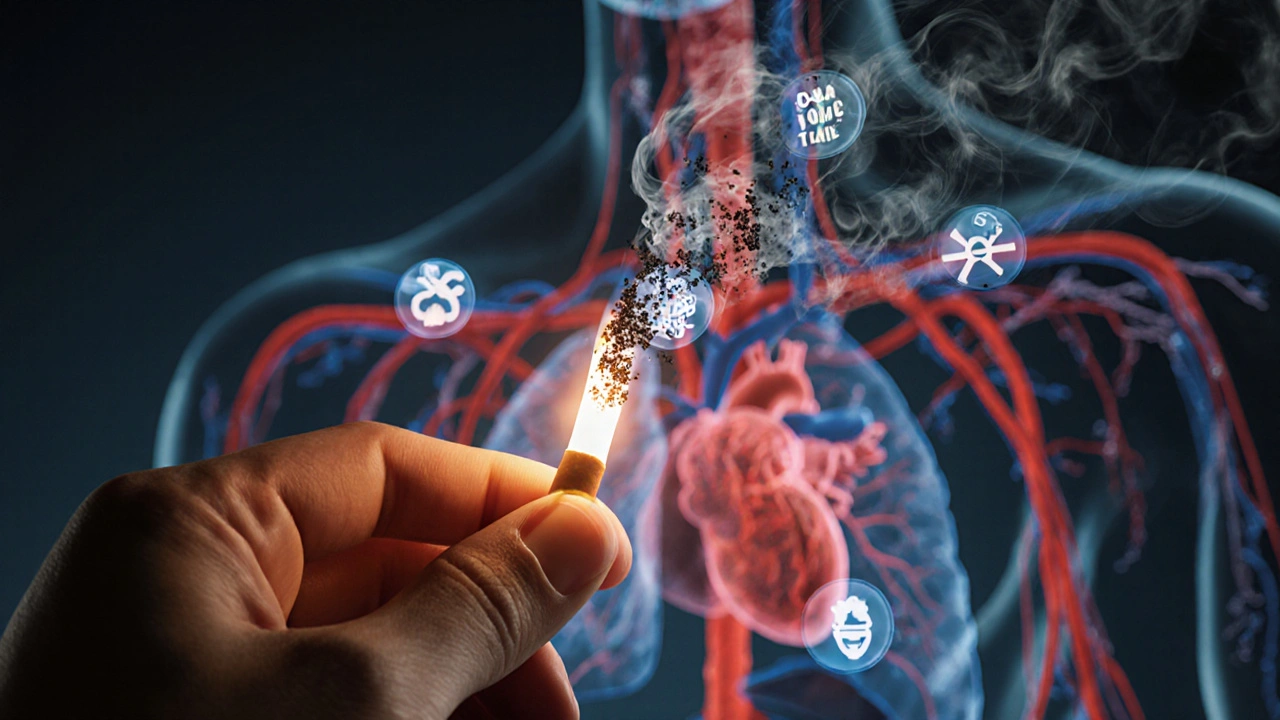


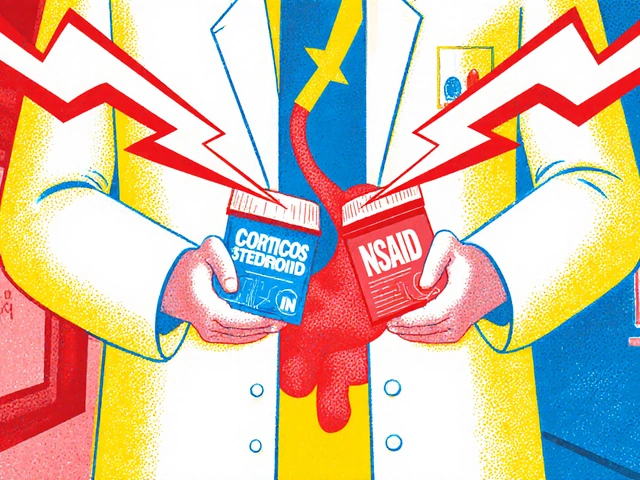

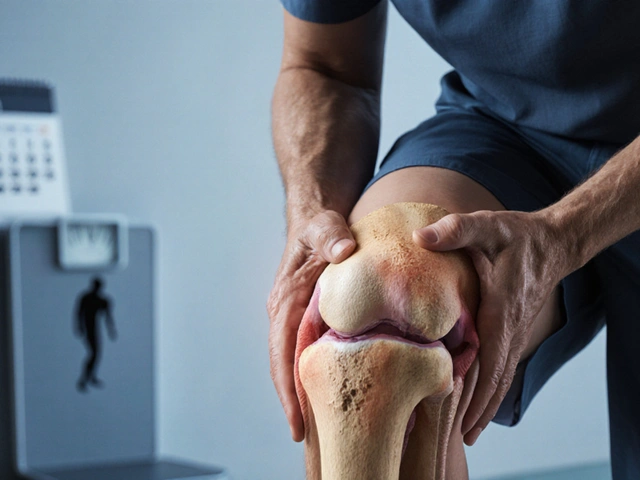
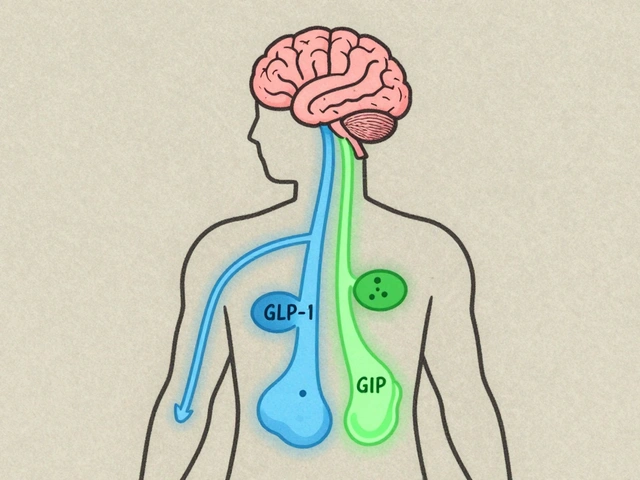
6 comments
Dheeraj Mehta
Quitting smoking is a realistic goal for anyone willing to try :)
Within a few weeks you’ll notice your breathing getting easier and your blood pressure dropping.
Over months, the risk of heart disease and stroke begins to decline sharply.
The calculator you saw is just a rough guide – the real improvement comes from the habit change itself.
Stay steady, keep tracking progress, and celebrate each small win.
Oliver Behr
Smoking kills; quit now.
Tiffany W
The pathophysiological sequelae of tobacco combustion epitomize a preventable iatrogenic burden.
From endothelial dysfunction to prothrombotic states, the cascade is both intricate and inexorable.
Thus, a moral imperative emerges for individuals to eschew this toxic exposure.
Failure to act not only jeopardizes personal health but also imposes externalities on public health systems.
Rajeshwar N.
The risk calculator oversimplifies a complex reality, reducing years of exposure to a single number.
It ignores genetic predisposition, diet, exercise, and socioeconomic factors that heavily modify outcomes.
While smoking is harmful, not every smoker faces the same cardiovascular destiny.
Policy‑driven warnings often ignore these nuances, creating unnecessary panic.
Take the data with a grain of salt and focus on comprehensive lifestyle changes.
Louis Antonio
Look, nicotine addiction is a beast that rewires your brain's reward pathways – it’s not just a ‘bad habit.’
When you light up, you get a surge of dopamine, and the body starts craving that hit.
The calculator’s numbers are just a baseline; real‑world risk spikes with each pack you down.
And don’t forget secondhand smoke – it drags your friends and family into the same danger zone.
Bottom line: the sooner you cut it out, the faster your arteries start to heal.
Don’t let corporate spin keep you chained.
Kyle Salisbury
From a cultural standpoint, many societies still glamorize smoking, making cessation a social hurdle.
However, awareness campaigns have shown measurable shifts when local role models speak out.
Integrating community support with medical advice yields the best outcomes.
Remember, quitting is as much a mental shift as it is a physical one.